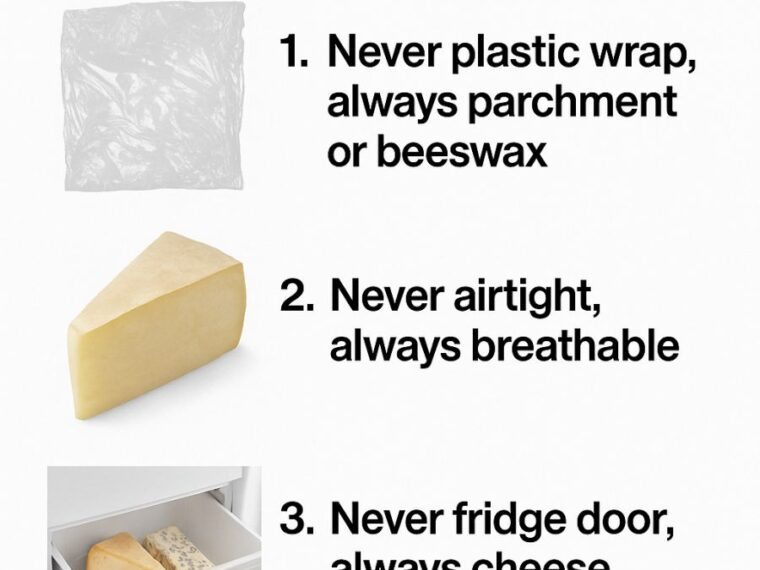Cheese is one of the most beloved and versatile foods in the culinary world. From sharp cheddars to creamy bries, cheese adds flavor, texture, and richness to countless dishes. Yet, despite its popularity, many people are storing cheese incorrectly, leading to wasted food and diminished quality. Proper cheese storage is crucial to maintaining its flavor, freshness, and nutritional value.
Missteps in cheese storage can result in hard, dry cheese or even worse, moldy and spoiled cheese. Knowing how to store cheese properly can enhance your culinary experiences and even save you money by reducing waste. Let’s explore the right way to store cheese and avoid common pitfalls.
1. Understanding the Importance of Proper Cheese Storage
Cheese is a living food, and its quality is highly dependent on how it is stored. Proper storage helps maintain its moisture content, flavor profile, and texture. Cheese consists of a delicate balance of fat and protein that can easily be disrupted by environmental factors such as temperature, humidity, and exposure to air.
By storing cheese correctly, you protect it from spoilage and excessive drying. For example, soft cheeses like brie and camembert should be stored at a temperature of 4-8°C (39-46°F) to maintain their creamy texture, while harder cheeses like parmesan can tolerate slightly cooler conditions.
2. Say Goodbye to Plastic Wrap: Opt for Parchment or Beeswax
Plastic wrap may seem convenient, but it can suffocate cheese, trapping moisture and promoting the growth of unwanted bacteria. Instead, opt for parchment paper or beeswax wraps, which allow cheese to breathe while retaining the necessary moisture.
Parchment paper is ideal for wrapping soft and semi-soft cheeses, as it prevents them from drying out without causing excessive sweating. Beeswax wraps are a sustainable option that naturally molds to the shape of the cheese, providing a protective yet breathable cover.
3. Avoid Airtight Containers: Embrace Breathable Alternatives
Airtight containers can create a micro-environment that fosters moisture buildup and encourages mold growth. Instead, use breathable alternatives such as cheese paper or specialized cheese storage bags.
Cheese paper has a dual layer that allows the cheese to breathe while maintaining optimal humidity levels. Cheese storage bags are designed with tiny perforations that achieve a similar effect, making them suitable for storing a variety of cheese types.
4. Why the Fridge Door is a No-Go for Cheese Storage
The fridge door might seem like a convenient spot for cheese, but it is actually one of the worst places to store it. The temperature fluctuations from opening and closing the door can compromise cheese quality, making it dry out or spoil faster.
Instead, store cheese in the main compartment of the fridge where the temperature is more consistent. Aim to keep cheese in the lower shelves or the cheese drawer for optimal conditions.
5. The Role of the Cheese Drawer in Maintaining Freshness
Many refrigerators come with a designated cheese drawer, which is specifically designed to maintain ideal humidity levels and temperature for cheese. This drawer helps to prevent moisture loss and protects cheese from other strong odors in the fridge.
Utilize the cheese drawer by organizing cheeses based on their type; softer cheeses should be stored separately from hard cheeses to prevent flavor transfer. Additionally, make sure the drawer is not overcrowded, allowing air to circulate properly around the cheese.
6. Why Freezing Cheese is a Mistake
While freezing cheese might seem like a good way to extend its shelf life, it can significantly alter the texture and flavor. The freezing process causes ice crystals to form, breaking down the cheese’s structure and resulting in a crumbly, less flavorful product.
Soft cheeses, in particular, do not freeze well and should be consumed fresh. Hard cheeses might fare slightly better, but they too can suffer from textural changes. It’s best to purchase cheese in amounts you can consume within its natural shelf life.
7. The Ideal Timeframe for Consuming Fresh Cheese
The freshness of cheese is key to its flavor and texture. Soft cheeses like ricotta and cottage cheese should be consumed within a week of opening. Semi-soft cheeses like gouda and havarti can last up to three weeks if stored properly.
Hard cheeses like cheddar and parmesan have a longer shelf life, often lasting up to six weeks. However, to enjoy cheese at its peak, it’s advisable to consume it within the first two weeks of opening.
8. How to Store Different Types of Cheese
Different cheeses have different storage needs. For instance, blue cheeses should be wrapped in foil to protect their delicate mold structure, while fresh cheeses like mozzarella should be stored in their brine to retain moisture.
Hard cheeses can be wrapped in cheese paper and placed in the cheese drawer. Washed-rind cheeses, known for their strong aroma, should be double-wrapped to prevent odor transfer to other foods in the fridge.
9. The Impact of Temperature on Cheese Flavor and Texture
Temperature plays a crucial role in the flavor and texture of cheese. Storing cheese at too high a temperature can cause it to sweat and develop off-flavors. Conversely, storing it too cold can make it hard and dull its flavor.
For optimal flavor, cheese should be brought to room temperature before serving, as this allows the fats and aromas to release fully. Ideally, remove cheese from the fridge about an hour before serving, allowing it to come to around 20°C (68°F).
10. Common Cheese Storage Mistakes to Avoid
One common mistake is storing cheese in close proximity to strongly scented foods, as cheese can easily absorb odors. Another mistake is not labeling cheese with the date it was opened, which can lead to forgetting how long it’s been stored.
Avoid cutting too far ahead of time; cheese should be cut just before serving to prevent excessive drying and flavor loss. Lastly, resist the urge to wash cheese with water to remove mold; instead, carefully trim away any moldy parts.
11. Tips for Extending Cheese Shelf Life Without Compromising Quality
To extend the shelf life of cheese, store it in the coolest part of the fridge, ideally at the back of a shelf. Ensure that cheeses are always wrapped properly to maintain moisture levels and prevent exposure to air
Rotate your cheese stock, consuming older cheeses first to prevent them from going bad. If you notice any signs of spoilage such as unpleasant odors or excessive mold, it’s best to discard the cheese. Remember, proper storage is key to enjoying cheese at its best.




